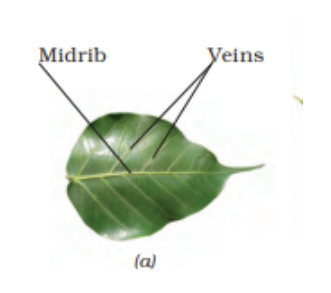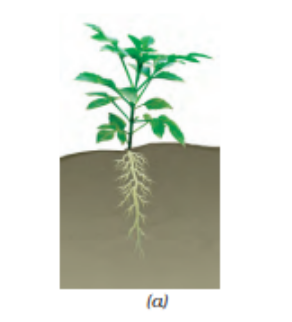
NCERT Solutions for Class 6 Science Chapter 7
NCERT Solutions for Class 6 Science Chapter 7: The NCERT Solutions for Class 6 Science encompass a range of questions to assist students in recognizing various question types related to specific topics. To achieve good marks in exams and gain a comprehensive understanding of advanced subjects, students are recommended to carefully review these solutions. These NCERT Solutions cover questions related to plant grouping, plant parts, transpiration process, roots and their functions, root types, leaf venation types, stem functions, flower parts, and their functions. Thoroughly going through these solutions is advised for better exam preparation and a deeper understanding of the subject matter.NCERT Solutions for Class 6 Science Chapter 7 Overview
The NCERT Solutions for Class 6 Science Chapter 7, "Getting to Know Plants," have been meticulously compiled to benefit students following the CBSE syllabus for Class 6 Science. This resource is designed to provide detailed and comprehensive answers, aiming to support students in gaining a profound understanding of the various concepts covered in the syllabus. The chapter "Getting to Know Plants" is a crucial component of the Class 6 Science curriculum, introducing students to the fascinating world of plants. The solutions offered here serve as a valuable aid in navigating through the complexities of the topic, ensuring clarity and a solid grasp of the subject matter. By utilising these NCERT Solutions , students can enhance their learning experience, reinforce their understanding of plant biology, and successfully prepare for examinations. The user-friendly presentation of the solutions facilitates easy access, ensuring that students can utilise this valuable resource at their convenience.NCERT Solutions for Class 6 Science Chapter 7 Getting to Know Plants
NCERT Solutions for Class 6 Science Chapter 7 Getting to Know Plants are provided here with simple step-by-step explanations. Chapter 7 Exercise Questions 1. Correct the following statements and rewrite them in your notebook.(a) Stem absorbs water and minerals from the soil.
(b) Leaves hold the plant upright.
(c) Roots conduct water to the leaves.
(d) The number of petals and stamens in a flower is always equal.
(e) If the sepals of a flower are joined together, its petals are also joined together.
(f) If the petals of a flower are joined together, then the pistil is joined to the petal.
Solution:
a) Roots absorb water and minerals from the soil. b) Stem holds the plant upright. c) Stems conduct water to the leaves. d) The number of petals and stamens in a flower may not always be equal. e) If the sepals of a flower are joined together, its petals are separate. f) If the petals of a flower are joined together, then the pistil may or may not be joined to the petal. 2. Draw (a) a leaf, (b) a taproot and (c) a flower you have studied for Table 7.3Solution:
a)
 Leaf
Leaf
b)
 Tap root
Tap root
c)
 Flower(Rose)
Flower(Rose) 3. Can you find a plant in your house or in your neighbourhood which has a long but weak stem? Write its name. In which category will you place it? Yes, the lauki (gourd) plant needs support. It is a climber. 4. What is the function of a stem? Following are the functions of a stem
- Stems hold the plant upright.
- Stems conduct water to the leaves.
- Stems conduct food from leaves to other parts of the plant.
| CBSE Syllabus Class 6 | |
| CBSE Class 6 Science Syllabus | CBSE Class 6 Maths Syllabus |
| CBSE Class 6 Social Science Syllabus | CBSE Class 6 English Syllabus |
Benefits of NCERT Solutions for Class 6 Science Chapter 7
The benefits of NCERT Solutions for Class 6 Science Chapter 7, "Getting to Know Plants," are multifaceted and play a crucial role in shaping students' understanding of the subject. Here is a detailed exploration of the advantages: 1. Conceptual Clarity: NCERT Solutions provide comprehensive explanations, aiding students in developing a clear understanding of the various concepts related to plants. 2. Exam Preparation: These solutions are tailored to the CBSE Class 6 Science syllabus, making them an excellent resource for exam preparation. By going through these solutions, students can familiarise themselves with the types of questions likely to be asked in exams. 3. Thorough Coverage: The solutions cover a spectrum of topics within Chapter 7, ensuring that students gain a holistic view of the subject matter. Detailed answers help in addressing a wide array of queries related to plant structure, functions, and significance. 4. Application of Knowledge: NCERT Solutions encourage the application of acquired knowledge to practical scenarios. Real-life examples and demonstrations provided in the solutions help students relate theoretical concepts to everyday experiences. 5. Self-assessment Opportunities: The solutions include a variety of questions and exercises that enable students to assess their understanding of the chapter. Regular self-assessment contributes to identifying areas that need further attention and improvement. 6. Enhanced Learning Experience: The solutions make the learning experience more engaging and interactive with practical examples and activities. Students can explore the world of plants through experiments and observations suggested in the solutions. 7. Accessible Format: Presented in a user-friendly format, these solutions are easily accessible to students. The convenience of accessing solutions in PDF format ensures flexibility in studying. 8. Clarity on Plant Anatomy and Functions: NCERT Solutions delve into plant anatomy, functions of different plant parts, and their ecological significance. Students gain a detailed understanding of the role each part plays in the life of a plant. 9. Foundation for Advanced Learning: Understanding plant biology at the foundational level prepares students for more advanced topics in subsequent classes. It lays the groundwork for a broader comprehension of biological sciences. 10. Encourages Curiosity and Exploration: The solutions foster curiosity by presenting intriguing aspects of plant life. They encourage students to explore further, fostering a genuine interest in the subject.Related Links -
How to Prepare With NCERT Solutions for Class 6 Science Chapter 7
Preparing with NCERT Solutions for Class 6 Science Chapter 7, "Getting to Know Plants," can significantly contribute to a student's understanding of the subject. Here's a detailed guide on how to effectively prepare using these solutions: 1. Read the Chapter Thoroughly: Start by reading Chapter 7 thoroughly to understand the basics of plant biology. Pay attention to the various topics covered, including plant parts, functions, and ecological significance. 2. Systematic Use of NCERT Solutions: Begin utilising NCERT Solutions for Class 6 Science Chapter 7 in a systematic manner. Go through each question and its corresponding solution to ensure a step-by-step understanding of the concepts. 3. Active Participation: Actively engage with the solutions by attempting to answer the questions on your own before referring to the provided answers. This approach enhances your problem-solving skills and reinforces your learning. 4. Practical Application of Concepts: Chapter 7 involves practical concepts related to plant structure and functions. Apply these concepts to real-life scenarios. Conduct simple experiments or observations to gain hands-on experience and reinforce theoretical knowledge. 5. Use of Real-life Examples: Understand the real-life examples and demonstrations provided in the solutions. Relate these examples to situations you encounter daily, making the learning experience more relatable and enjoyable. 6. Clarify Doubts Promptly: If you encounter doubts or difficulties in understanding certain concepts, revisit the relevant sections of the solutions. Seek clarification from teachers, classmates, or other resources to ensure a clear understanding. 7. Self-assessment and Review: Regularly assess your understanding by attempting the self-assessment questions and review exercises provided in the NCERT Solutions. Identify areas where you may need further clarification and revisit those sections for reinforcement. 8. Experiment with Activities: NCERT Solutions often include activities. Try to perform these activities to gain a deeper understanding. Practical involvement reinforces theoretical concepts and makes learning more engaging. 9. Consistent Revision: Plan a schedule for consistent revision of the chapter to reinforce your learning. Regular revision ensures that the concepts stay fresh in your memory, making it easier to recall information during exams. 10. Utilise Additional Resources: While NCERT Solutions are comprehensive, supplement your learning with additional resources such as reference books or online tutorials. Gain different perspectives to enhance your overall understanding. 11. Simulate Exam Conditions: As exams approach, simulate exam conditions by practising with a time limit and adhering to the exam pattern. This practice helps you manage time effectively during the actual examination. 12. Reflect and Improve: Reflect on your performance in practice tests and identify areas for improvement. Focus on refining your problem-solving skills and addressing any weaknesses in your understanding of the chapter.NCERT Solutions for Class 6 Science Chapter 7 Topic Wise Discussion
Here's a topic wise discussion on the Chapter Getting to Know Plants. Earth in the solar system is the only planet that has likely conditions for life to exist. The presence of oxygen and water is the primary cause behind this; however, we must not underestimate the unimaginable contribution of plants. Let’s have a look. 7.1 Herbs, Shrubs, and Trees Plants are categorised into herbs, shrubs, and trees based on the thickness of the stem and the origin of the branches. The stems of herbs are green and frail, and they are generally small plants with few branches. Examples include coriander, basil, oregano, thyme, mint, rosemary, parsley, etc. Herbs lack woody stems, making them less robust than trees. They are usually under a metre tall and have a relatively short lifespan, lasting only for a season or two. Despite this, herbs are known for their flowering scents and may possess medicinal values. Additionally, herbs offer nutritional benefits and add flavour when used in cooking, as exemplified by coriander leaves. Shrubs Medium-sized plants are referred to as shrubs. They are more extensive in width, height, and breadth compared to herbs, featuring slender branches that grow from the base. Examples include lemon, rose, jasmine, aloe vera, blackberry, etc. Shrubs are taller than herbs but shorter than trees, with hard and woody stems that are not as thick as those of trees. While shrubs can live for many years, their lifespan does not exceed that of trees. Trees Trees surpass both shrubs and herbs in size and height. With sturdy stems and branches spreading out after a specific height, trees, like Neem, Peepal, Coconut, Mango, and Banyan, have a distinctive trunk and large main branches. Trees provide ample shade to the ground beneath them as they grow. 7.2 Stem The stem serves as a conduit for water to travel to different parts of the plant, along with minerals from the water. Thin tubes within the stem facilitate the transport of minerals and water to leaves and every tip of the plant. Bearing flowers, branches, fruits, leaves, and buds, the stem plays a crucial role in supplying nutrients and water obtained from the roots, supporting the process of photosynthesis. 7.3 Leaf Leaves' sizes, shapes, and colours vary depending on the plant type. The part connecting leaves to the stem is the petiole, while the green leaf portion is the lamina. Veins, resembling a backbone and spreading sideways, are visible across leaves. The primary vein is the midrib, and the overall vein pattern is known as leaf venation. Some leaves have parallel veins, aiding in specific functions. 7.4 Root The root, a vital part of the plant, absorbs essential nutrients, including water and minerals, crucial for its growth. Roots anchor plants and provide stability, supporting an upright position. Categorised into fibrous roots and taproots, they also act as a storage house for nutrients and food necessary for growth. 7.5 Flower Flowers, located at the end of a stem, are the decorative and seed-bearing parts of a plant. Petals contribute to the flower's colour, forming the Corolla. Sepals, leaf-like structures, enclose and protect the petals, playing a vital role, especially when the flower is in bud form. The stamen is concealed inside the flower and becomes visible when petals are removed.NCERT Solutions for Class 6 Science Chapter 7 FAQs
What are the parts of a flower Class 6 Science Chapter 7?
The parts of a flower in Class 6 Science Chapter 7 include the corolla formed by colourful petals, the protective sepal, the stamen (male reproductive part), and the pistil (female reproductive part).
What is the function of stem Class 6 NCERT solutions?
In Class 6 NCERT solutions, the stem's function is to transport water, minerals, and nutrients to various parts of the plant, supporting the growth of flowers, branches, leaves, and buds.
What is style class 6?
In Class 6, the style refers to the slender tube-like part of the pistil in a flower, connecting the stigma and ovary, playing a crucial role in the reproduction process.
What is leaf class 6?
In Class 6, a leaf is the green part of a plant connected to the stem by a petiole. Leaves have veins, including a midrib, and their size, shape, and colour vary among different plant types.
What is the female part of a flower?
The female part of a flower is the pistil, comprising the stigma, style, and ovary. The ovary houses ovules, and the pistil plays a key role in the plant's reproductive process.
Talk to a counsellorHave doubts? Our support team will be happy to assist you!

Check out these Related Articles
Free Learning Resources
PW Books
Notes (Class 10-12)
PW Study Materials
Notes (Class 6-9)
Ncert Solutions
Govt Exams
Class 6th to 12th Online Courses
Govt Job Exams Courses
UPSC Coaching
Defence Exam Coaching
Gate Exam Coaching
Other Exams
Know about Physics Wallah
Physics Wallah is an Indian edtech platform that provides accessible & comprehensive learning experiences to students from Class 6th to postgraduate level. We also provide extensive NCERT solutions, sample paper, NEET, JEE Mains, BITSAT previous year papers & more such resources to students. Physics Wallah also caters to over 3.5 million registered students and over 78 lakh+ Youtube subscribers with 4.8 rating on its app.
We Stand Out because
We provide students with intensive courses with India’s qualified & experienced faculties & mentors. PW strives to make the learning experience comprehensive and accessible for students of all sections of society. We believe in empowering every single student who couldn't dream of a good career in engineering and medical field earlier.
Our Key Focus Areas
Physics Wallah's main focus is to make the learning experience as economical as possible for all students. With our affordable courses like Lakshya, Udaan and Arjuna and many others, we have been able to provide a platform for lakhs of aspirants. From providing Chemistry, Maths, Physics formula to giving e-books of eminent authors like RD Sharma, RS Aggarwal and Lakhmir Singh, PW focuses on every single student's need for preparation.
What Makes Us Different
Physics Wallah strives to develop a comprehensive pedagogical structure for students, where they get a state-of-the-art learning experience with study material and resources. Apart from catering students preparing for JEE Mains and NEET, PW also provides study material for each state board like Uttar Pradesh, Bihar, and others
Copyright © 2025 Physicswallah Limited All rights reserved.
Get App







